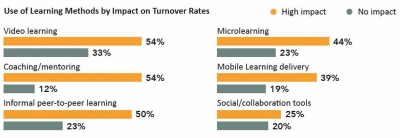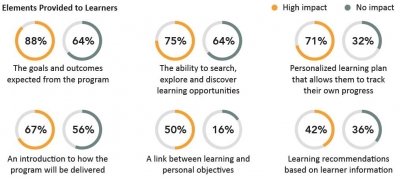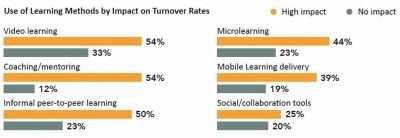This post was originally published on this site
Organizations in industries with higher-than-average turnover rates face a constant battle: How can they quickly get new employees up to speed and retain current employees? Instead of simply accepting high turnover as a routine part of business, Learning and Development (L&D) can have a huge impact on mitigating the risks associated with a rapidly-shifting workforce.
Though many organizations are challenged by high turnover, we see it most often in industries such as construction, manufacturing, health care, hospitality, food and beverage, and retail. Location and scale do not insulate these organizations, either. High-turnover companies range in size from hundreds of employees to tens of thousands, and they can have any type of geographic footprint.
The biggest training challenge is the sheer speed with which the learning must engage and impact learners. If you expand that across a large organization with a global presence, the challenge becomes that much greater, but that is not all that is at stake.
Whether the turnover rates are due to voluntary or involuntary departures, the result is often the same—a need for new workers to be running at optimum productivity quickly. High turnover also puts pressure on retaining people once they are up to speed.
Damages
Getting this wrong can damage any organization. The costs of hiring and rehiring far outpace those of training and developing successful employees—in addition to the sunk cost of training that was provided and walked out the door with departing workers.
High turnover also has a huge impact on consistency and the organization’s ability to deliver the same level of customer experience over time and across geographies. If we look at the retail industry in particular, market demands are constantly shifting, so companies need to stay ahead. It can be difficult for traditional learning content, methods, and modalities to keep up. Learning must be more iterative and adaptive to meet the unique needs of the changing market and workforce.
When we look at companies in these high-turnover industries that say their learning approach has a positive impact on their turnover rates, we see that they are far more likely to use modern learning approaches more often than their counterparts who are unable to impact turnover rates.

Brandon Hall Group, Learner Experience Study, 2019
5 Essential Issues to Consider
- How can organizations in high-turnover industries deliver quality training at scale?
- How can these companies mitigate the risks associated with turnover?
- What learning approaches make the most sense?
- What role does technology play?
Brandon Hall Group POV
As we’ve seen, companies having success with mitigating turnover approach learning technology differently. They also have a different approach to learning overall. When it comes to the overall learning strategy, these companies are far more likely to include feedback from learners, which helps ensure a more learning-focused experience. They are also more likely to align the strategy with learner objectives.
To ensure the experience is truly contextual for learners, high-impact companies provide recommendations to learners based on things such as their role, career path, and the learning they previously have interacted with. They also give learners a link between the learning they are offered and their personal objectives. Too often, companies believe the “what’s in it for me” factor for learning is implicit, but employees who understand the connection between themselves, learning, and the business are more engaged and poised for success. These foundational elements are critical for organizations that are serious about people-centered learning.
These organizations also understand that learners need time and opportunities to reflect, reinforce, and apply the knowledge they are gaining, and make efforts to ensure these things are happening.

Brandon Hall Group, Learner Experience Study, 2019
5 Key Takeaways
- Focus on onboarding. It’s not just about filling out forms.
- Continue to develop people to mitigate turnover.
- Think digital. Traditional models cannot keep up with the pace of business.
- Leverage existing internal knowledge to boost everyone’s knowledge.
- Shorter, faster learning does not mean lower quality.
To download a free copy of Brandon Hall Group’s 2020 HCM Outlook Book: The Future of the Employee Experience, click here.
David Wentworth is principal learning analyst at Brandon Hall Group. The firm’s vision is to inspire a better workplace experience, and its mission is to empower excellence in organizations around the world through its research and tools. Brandon Hall Group has five HCM practices and produces the Brandon Hall Group HCM Excellence Awards and the annual HCM Excellence Conference, in West Palm Beach, FL.

